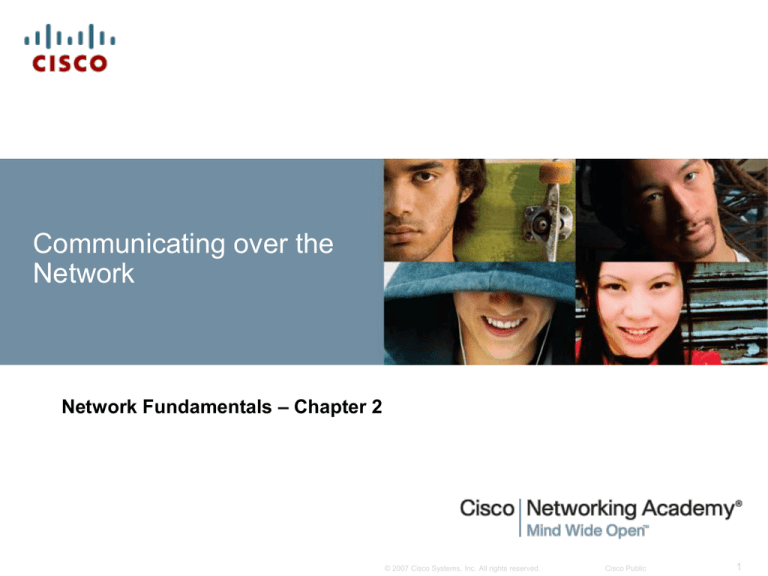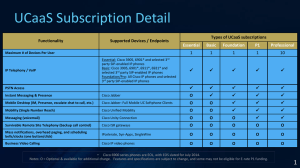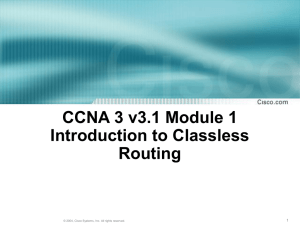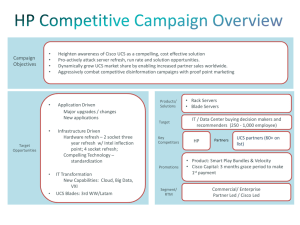
Communicating over the
Network
Network Fundamentals – Chapter 2
© 2007 Cisco Systems, Inc. All rights reserved.
Cisco Public
1
Objectives
Describe the structure of a network, including the
devices and media that are necessary for successful
communications.
Explain the function of protocols in network
communications.
Explain the advantages of using a layered model to
describe network functionality.
Describe the role of each layer in two recognized
network models: The TCP/IP model and the OSI
model.
Describe the importance of addressing and naming
schemes in network communications.
© 2007 Cisco Systems, Inc. All rights reserved.
Cisco Public
2
Network Structure
Define the elements of communication
–3 common elements of communication
•
message source
•
the channel
•
message destination
Define a network
data or information networks capable of carrying many different
types of communications
© 2007 Cisco Systems, Inc. All rights reserved.
Cisco Public
3
Network Structure
In theory, a single communication, such as a music
video or an e-mail message, could be sent across a
network from a source to a destination as one massive
continuous stream of bits
If messages were actually transmitted in this manner, it
would mean that no other device would be able to send
or receive messages on the same network while this
data transfer was in progress.
These large streams of data would result in significant
delays.
© 2007 Cisco Systems, Inc. All rights reserved.
Cisco Public
4
Network Structure
If a link in the interconnected network infrastructure
failed during the transmission, the complete message
would be lost and have to be retransmitted in full.
A better approach is to divide the data into smaller,
more manageable pieces to send over the network.
This division of the data stream into smaller pieces is
called segmentation.
© 2007 Cisco Systems, Inc. All rights reserved.
Cisco Public
5
Network Structure
Describe how messages are communicated
Data is sent across a network in small “chunks” called
segments
© 2007 Cisco Systems, Inc. All rights reserved.
Cisco Public
6
Network Structure (Segmentation 1)
Segmenting messages has two primary benefits:
•First, by sending smaller individual pieces from source to destination, many different conversations can
be interleaved on the network. (Multiplexing)
•Second, segmentation can increase the reliability of network communications.
© 2007 Cisco Systems, Inc. All rights reserved.
Cisco Public
7
Network Structure (Segmentation 2)
Advantages of segmentation
•The separate pieces of each message need not travel the same pathway across the network from
source to destination.
• If a particular path becomes congested with data traffic or fails, individual pieces of the message can
still be directed to the destination using alternate pathways.
•If part of the message fails to make it to the destination, only the missing parts need to be retransmitted.
© 2007 Cisco Systems, Inc. All rights reserved.
Cisco Public
8
Network Structure
Define the components of a network
–Network components
•
hardware (End devices and media)
•
software
© 2007 Cisco Systems, Inc. All rights reserved.
Cisco Public
9
Network Structure
End Devices and their Role in the Network
–End devices form interface with human network &
communications network
–Role of end devices:
•
client
•
server
•
both client and server
© 2007 Cisco Systems, Inc. All rights reserved.
Cisco Public
10
Network Structure
Services and processes are the communication programs, called software, that run on
the networked devices.
A network service provides information in response to a request.
•Services include many of the common network applications people use every day, like e-mail
hosting services and web hosting services.
•Processes provide the functionality that directs and moves the messages through the network.
(NOTE: Processes are less obvious to us but are critical to the operation of networks. )
© 2007 Cisco Systems, Inc. All rights reserved.
Cisco Public
11
Network Structure
Identify the role of an intermediary device in a data
network and be able to contrast that role with the role of
an end device
–Role of an intermediary device
•
provides connectivity and ensures data flows
across network
© 2007 Cisco Systems, Inc. All rights reserved.
Cisco Public
12
Network Structure
Define network media and criteria for making a network
media choice
Network media
this is the channel over which a message travels
© 2007 Cisco Systems, Inc. All rights reserved.
Cisco Public
13
Network Types
Define Local Area Networks (LANs)
- A network serving a home, building or campus is considered a
Local Area Network (LAN)
© 2007 Cisco Systems, Inc. All rights reserved.
Cisco Public
14
Network Types
Define Wide Area Networks (WANs)
- LANs separated by geographic distance are connected by a
network known as a Wide Area Network (WAN)
© 2007 Cisco Systems, Inc. All rights reserved.
Cisco Public
15
Network Types
Define the Internet
The internet is defined as a
global mesh of interconnected networks
© 2007 Cisco Systems, Inc. All rights reserved.
Cisco Public
16
Network Types
Describe network representations
© 2007 Cisco Systems, Inc. All rights reserved.
Cisco Public
17
Function of Protocol in Network
Communication
The importance of protocols and how they are used to
facilitate communication over data networks
A protocol is a set of predetermined rules
© 2007 Cisco Systems, Inc. All rights reserved.
Cisco Public
18
Function of Protocol in Network
Communication
Explain network protocols
Network protocols are used
to allow devices to
communicate
successfully
© 2007 Cisco Systems, Inc. All rights reserved.
Cisco Public
19
Function of Protocol in Network
Communication
© 2007 Cisco Systems, Inc. All rights reserved.
Cisco Public
20
Function of Protocol in Network
Communication
© 2007 Cisco Systems, Inc. All rights reserved.
Cisco Public
21
Function of Protocol in Network
Communication
© 2007 Cisco Systems, Inc. All rights reserved.
Cisco Public
22
Function of Protocol in Network
Communication
© 2007 Cisco Systems, Inc. All rights reserved.
Cisco Public
23
Function of Protocol in Network
Communication
Describe Protocol suites and industry standards
A standard is
a process or protocol that has been endorsed by the
networking industry and ratified by a standards organization
© 2007 Cisco Systems, Inc. All rights reserved.
Cisco Public
24
Function of Protocol in Network
Communication
Define different protocols and how they interact
© 2007 Cisco Systems, Inc. All rights reserved.
Cisco Public
25
Function of Protocol in Network
Communication
Technology independent Protocols
-Many diverse types of devices can communicate using the
same sets of protocols. This is because protocols specify
network functionality, not the underlying technology to support
this functionality.
© 2007 Cisco Systems, Inc. All rights reserved.
Cisco Public
26
Layers with TCP/IP and OSI Model
Explain the benefits of using a layered model
–Benefits include
• assists in protocol design
• fosters competition
• changes in one layer do not affect other layers
• provides a common language
© 2007 Cisco Systems, Inc. All rights reserved.
Cisco Public
27
Layers with TCP/IP and OSI Model
Describe TCP/IP Mode
© 2007 Cisco Systems, Inc. All rights reserved.
Cisco Public
28
Layers with TCP/IP and OSI Model
Describe the Communication Process
© 2007 Cisco Systems, Inc. All rights reserved.
Cisco Public
29
Layers with TCP/IP and OSI Model
Explain protocol data units (PDU) and encapsulation
Protocol Data Units
(PDU)
Segmentation
© 2007 Cisco Systems, Inc. All rights reserved.
Cisco Public
30
Layers with TCP/IP and OSI Model
Describe the process of sending and receiving
messages
© 2007 Cisco Systems, Inc. All rights reserved.
Cisco Public
31
Layers with TCP/IP and OSI Model
Explain protocol and
reference models
A protocol model
provides a model that
closely matches the
structure of a particular
protocol suite.
A reference model
provides a common
reference for
maintaining
consistency within all
types of network
protocols and services.
© 2007 Cisco Systems, Inc. All rights reserved.
Cisco Public
32
Layers with TCP/IP and OSI Model
Define OSI
All
People
Seem
To
Need
Data
Processing
© 2007 Cisco Systems, Inc. All rights reserved.
Cisco Public
33
Layers with TCP/IP and OSI Model
Compare OSI and TCP/IP model
© 2007 Cisco Systems, Inc. All rights reserved.
Cisco Public
34
Addressing and Naming Schemes
Explain how labels in encapsulation headers are used
to manage communication in data networks
© 2007 Cisco Systems, Inc. All rights reserved.
Cisco Public
35
Addressing and Naming Schemes
Describe examples of Ethernet MAC Addresses, IP
Addresses, and TCP/UDP Port numbers
© 2007 Cisco Systems, Inc. All rights reserved.
Cisco Public
36
Addressing and Naming Schemes
Explain how labels in encapsulation headers are used
to manage communication in data networks
© 2007 Cisco Systems, Inc. All rights reserved.
Cisco Public
37
Addressing and Naming Schemes
Describe how information in the encapsulation header
is used to identify the source and destination processes
for data communication
© 2007 Cisco Systems, Inc. All rights reserved.
Cisco Public
38
Summary
© 2007 Cisco Systems, Inc. All rights reserved.
Cisco Public
39









